Edward W Huang
Unleashing the Power of LLMs as Multi-Modal Encoders for Text and Graph-Structured Data
Oct 15, 2024



Abstract:Graph-structured information offers rich contextual information that can enhance language models by providing structured relationships and hierarchies, leading to more expressive embeddings for various applications such as retrieval, question answering, and classification. However, existing methods for integrating graph and text embeddings, often based on Multi-layer Perceptrons (MLPs) or shallow transformers, are limited in their ability to fully exploit the heterogeneous nature of these modalities. To overcome this, we propose Janus, a simple yet effective framework that leverages Large Language Models (LLMs) to jointly encode text and graph data. Specifically, Janus employs an MLP adapter to project graph embeddings into the same space as text embeddings, allowing the LLM to process both modalities jointly. Unlike prior work, we also introduce contrastive learning to align the graph and text spaces more effectively, thereby improving the quality of learned joint embeddings. Empirical results across six datasets spanning three tasks, knowledge graph-contextualized question answering, graph-text pair classification, and retrieval, demonstrate that Janus consistently outperforms existing baselines, achieving significant improvements across multiple datasets, with gains of up to 11.4% in QA tasks. These results highlight Janus's effectiveness in integrating graph and text data. Ablation studies further validate the effectiveness of our method.
Covering a Graph with Dense Subgraph Families, via Triangle-Rich Sets
Jul 23, 2024

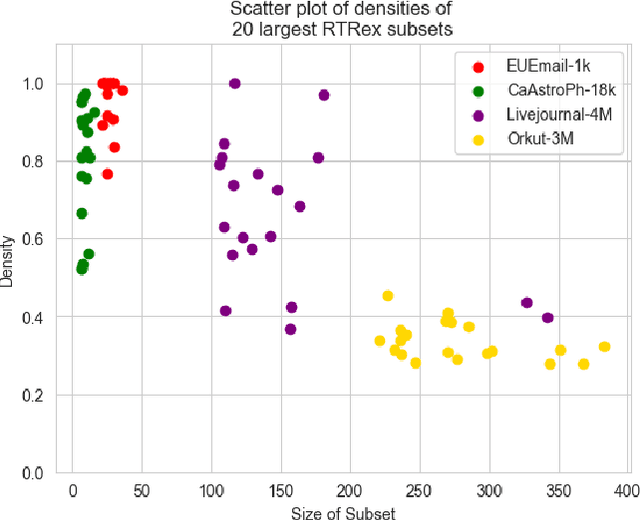
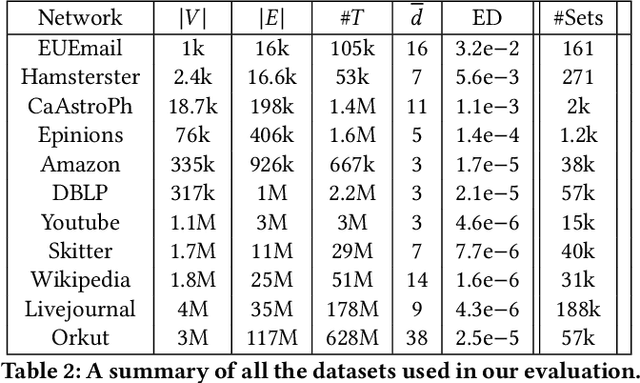
Abstract:Graphs are a fundamental data structure used to represent relationships in domains as diverse as the social sciences, bioinformatics, cybersecurity, the Internet, and more. One of the central observations in network science is that real-world graphs are globally sparse, yet contains numerous "pockets" of high edge density. A fundamental task in graph mining is to discover these dense subgraphs. Most common formulations of the problem involve finding a single (or a few) "optimally" dense subsets. But in most real applications, one does not care for the optimality. Instead, we want to find a large collection of dense subsets that covers a significant fraction of the input graph. We give a mathematical formulation of this problem, using a new definition of regularly triangle-rich (RTR) families. These families capture the notion of dense subgraphs that contain many triangles and have degrees comparable to the subgraph size. We design a provable algorithm, RTRExtractor, that can discover RTR families that approximately cover any RTR set. The algorithm is efficient and is inspired by recent results that use triangle counts for community testing and clustering. We show that RTRExtractor has excellent behavior on a large variety of real-world datasets. It is able to process graphs with hundreds of millions of edges within minutes. Across many datasets, RTRExtractor achieves high coverage using high edge density datasets. For example, the output covers a quarter of the vertices with subgraphs of edge density more than (say) $0.5$, for datasets with 10M+ edges. We show an example of how the output of RTRExtractor correlates with meaningful sets of similar vertices in a citation network, demonstrating the utility of RTRExtractor for unsupervised graph discovery tasks.
All Against Some: Efficient Integration of Large Language Models for Message Passing in Graph Neural Networks
Jul 20, 2024



Abstract:Graph Neural Networks (GNNs) have attracted immense attention in the past decade due to their numerous real-world applications built around graph-structured data. On the other hand, Large Language Models (LLMs) with extensive pretrained knowledge and powerful semantic comprehension abilities have recently shown a remarkable ability to benefit applications using vision and text data. In this paper, we investigate how LLMs can be leveraged in a computationally efficient fashion to benefit rich graph-structured data, a modality relatively unexplored in LLM literature. Prior works in this area exploit LLMs to augment every node features in an ad-hoc fashion (not scalable for large graphs), use natural language to describe the complex structural information of graphs, or perform computationally expensive finetuning of LLMs in conjunction with GNNs. We propose E-LLaGNN (Efficient LLMs augmented GNNs), a framework with an on-demand LLM service that enriches message passing procedure of graph learning by enhancing a limited fraction of nodes from the graph. More specifically, E-LLaGNN relies on sampling high-quality neighborhoods using LLMs, followed by on-demand neighborhood feature enhancement using diverse prompts from our prompt catalog, and finally information aggregation using message passing from conventional GNN architectures. We explore several heuristics-based active node selection strategies to limit the computational and memory footprint of LLMs when handling millions of nodes. Through extensive experiments & ablation on popular graph benchmarks of varying scales (Cora, PubMed, ArXiv, & Products), we illustrate the effectiveness of our E-LLaGNN framework and reveal many interesting capabilities such as improved gradient flow in deep GNNs, LLM-free inference ability etc.
An Interpretable Ensemble of Graph and Language Models for Improving Search Relevance in E-Commerce
Mar 01, 2024



Abstract:The problem of search relevance in the E-commerce domain is a challenging one since it involves understanding the intent of a user's short nuanced query and matching it with the appropriate products in the catalog. This problem has traditionally been addressed using language models (LMs) and graph neural networks (GNNs) to capture semantic and inter-product behavior signals, respectively. However, the rapid development of new architectures has created a gap between research and the practical adoption of these techniques. Evaluating the generalizability of these models for deployment requires extensive experimentation on complex, real-world datasets, which can be non-trivial and expensive. Furthermore, such models often operate on latent space representations that are incomprehensible to humans, making it difficult to evaluate and compare the effectiveness of different models. This lack of interpretability hinders the development and adoption of new techniques in the field. To bridge this gap, we propose Plug and Play Graph LAnguage Model (PP-GLAM), an explainable ensemble of plug and play models. Our approach uses a modular framework with uniform data processing pipelines. It employs additive explanation metrics to independently decide whether to include (i) language model candidates, (ii) GNN model candidates, and (iii) inter-product behavioral signals. For the task of search relevance, we show that PP-GLAM outperforms several state-of-the-art baselines as well as a proprietary model on real-world multilingual, multi-regional e-commerce datasets. To promote better model comprehensibility and adoption, we also provide an analysis of the explainability and computational complexity of our model. We also provide the public codebase and provide a deployment strategy for practical implementation.
Communication-Free Distributed GNN Training with Vertex Cut
Aug 06, 2023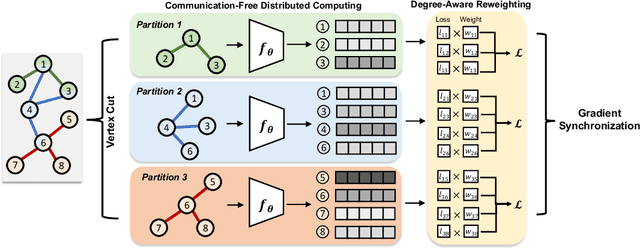



Abstract:Training Graph Neural Networks (GNNs) on real-world graphs consisting of billions of nodes and edges is quite challenging, primarily due to the substantial memory needed to store the graph and its intermediate node and edge features, and there is a pressing need to speed up the training process. A common approach to achieve speed up is to divide the graph into many smaller subgraphs, which are then distributed across multiple GPUs in one or more machines and processed in parallel. However, existing distributed methods require frequent and substantial cross-GPU communication, leading to significant time overhead and progressively diminishing scalability. Here, we introduce CoFree-GNN, a novel distributed GNN training framework that significantly speeds up the training process by implementing communication-free training. The framework utilizes a Vertex Cut partitioning, i.e., rather than partitioning the graph by cutting the edges between partitions, the Vertex Cut partitions the edges and duplicates the node information to preserve the graph structure. Furthermore, the framework maintains high model accuracy by incorporating a reweighting mechanism to handle a distorted graph distribution that arises from the duplicated nodes. We also propose a modified DropEdge technique to further speed up the training process. Using an extensive set of experiments on real-world networks, we demonstrate that CoFree-GNN speeds up the GNN training process by up to 10 times over the existing state-of-the-art GNN training approaches.
You Only Transfer What You Share: Intersection-Induced Graph Transfer Learning for Link Prediction
Feb 27, 2023



Abstract:Link prediction is central to many real-world applications, but its performance may be hampered when the graph of interest is sparse. To alleviate issues caused by sparsity, we investigate a previously overlooked phenomenon: in many cases, a densely connected, complementary graph can be found for the original graph. The denser graph may share nodes with the original graph, which offers a natural bridge for transferring meaningful knowledge. We identify this setting as Graph Intersection-induced Transfer Learning (GITL), which is motivated by practical applications in e-commerce or academic co-authorship predictions. We develop a framework to effectively leverage the structural prior in this setting. We first create an intersection subgraph using the shared nodes between the two graphs, then transfer knowledge from the source-enriched intersection subgraph to the full target graph. In the second step, we consider two approaches: a modified label propagation, and a multi-layer perceptron (MLP) model in a teacher-student regime. Experimental results on proprietary e-commerce datasets and open-source citation graphs show that the proposed workflow outperforms existing transfer learning baselines that do not explicitly utilize the intersection structure.
Search Behavior Prediction: A Hypergraph Perspective
Nov 29, 2022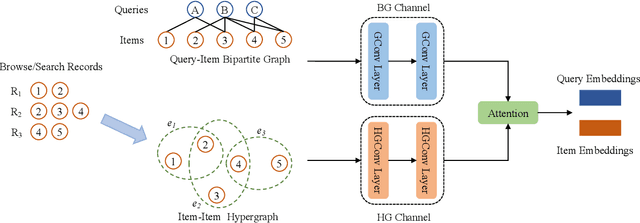
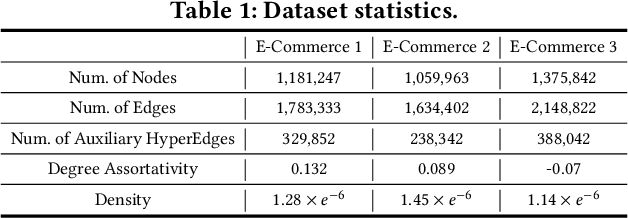
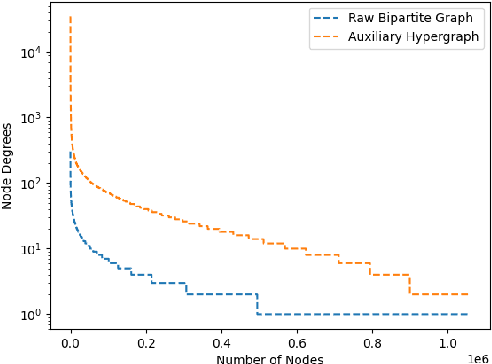
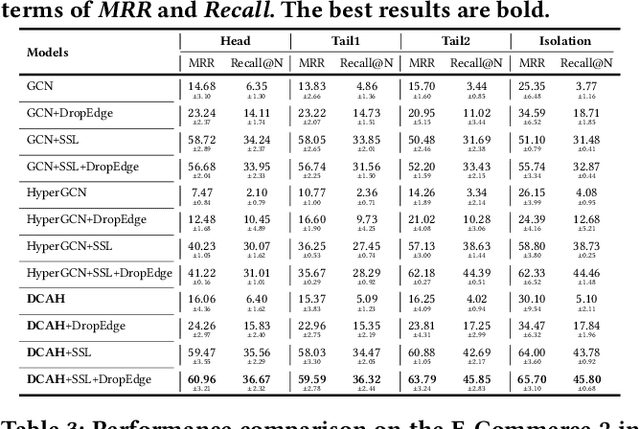
Abstract:Although the bipartite shopping graphs are straightforward to model search behavior, they suffer from two challenges: 1) The majority of items are sporadically searched and hence have noisy/sparse query associations, leading to a \textit{long-tail} distribution. 2) Infrequent queries are more likely to link to popular items, leading to another hurdle known as \textit{disassortative mixing}. To address these two challenges, we go beyond the bipartite graph to take a hypergraph perspective, introducing a new paradigm that leverages \underline{auxiliary} information from anonymized customer engagement sessions to assist the \underline{main task} of query-item link prediction. This auxiliary information is available at web scale in the form of search logs. We treat all items appearing in the same customer session as a single hyperedge. The hypothesis is that items in a customer session are unified by a common shopping interest. With these hyperedges, we augment the original bipartite graph into a new \textit{hypergraph}. We develop a \textit{\textbf{D}ual-\textbf{C}hannel \textbf{A}ttention-Based \textbf{H}ypergraph Neural Network} (\textbf{DCAH}), which synergizes information from two potentially noisy sources (original query-item edges and item-item hyperedges). In this way, items on the tail are better connected due to the extra hyperedges, thereby enhancing their link prediction performance. We further integrate DCAH with self-supervised graph pre-training and/or DropEdge training, both of which effectively alleviate disassortative mixing. Extensive experiments on three proprietary E-Commerce datasets show that DCAH yields significant improvements of up to \textbf{24.6\% in mean reciprocal rank (MRR)} and \textbf{48.3\% in recall} compared to GNN-based baselines. Our source code is available at \url{https://github.com/amazon-science/dual-channel-hypergraph-neural-network}.
TuneUp: A Training Strategy for Improving Generalization of Graph Neural Networks
Oct 26, 2022Abstract:Despite many advances in Graph Neural Networks (GNNs), their training strategies simply focus on minimizing a loss over nodes in a graph. However, such simplistic training strategies may be sub-optimal as they neglect that certain nodes are much harder to make accurate predictions on than others. Here we present TuneUp, a curriculum learning strategy for better training GNNs. Crucially, TuneUp trains a GNN in two stages. The first stage aims to produce a strong base GNN. Such base GNNs tend to perform well on head nodes (nodes with large degrees) but less so on tail nodes (nodes with small degrees). So, the second stage of TuneUp specifically focuses on improving prediction on tail nodes. Concretely, TuneUp synthesizes many additional supervised tail node data by dropping edges from head nodes and reusing the supervision on the original head nodes. TuneUp then minimizes the loss over the synthetic tail nodes to finetune the base GNN. TuneUp is a general training strategy that can be used with any GNN architecture and any loss, making TuneUp applicable to a wide range of prediction tasks. Extensive evaluation of TuneUp on two GNN architectures, three types of prediction tasks, and both inductive and transductive settings shows that TuneUp significantly improves the performance of the base GNN on tail nodes, while often even improving the performance on head nodes, which together leads up to 58.5% relative improvement in GNN predictive performance. Moreover, TuneUp significantly outperforms its variants without the two-stage curriculum learning, existing graph data augmentation techniques, as well as other specialized methods for tail nodes.
Cold Brew: Distilling Graph Node Representations with Incomplete or Missing Neighborhoods
Nov 10, 2021



Abstract:Graph Neural Networks (GNNs) have achieved state of the art performance in node classification, regression, and recommendation tasks. GNNs work well when high-quality and rich connectivity structure is available. However, this requirement is not satisfied in many real world graphs where the node degrees have power-law distributions as many nodes have either fewer or noisy connections. The extreme case of this situation is a node may have no neighbors at all, called Strict Cold Start (SCS) scenario. This forces the prediction models to rely completely on the node's input features. We propose Cold Brew to address the SCS and noisy neighbor setting compared to pointwise and other graph-based models via a distillation approach. We introduce feature-contribution ratio (FCR), a metric to study the viability of using inductive GNNs to solve the SCS problem and to select the best architecture for SCS generalization. We experimentally show FCR disentangles the contributions of various components of graph datasets and demonstrate the superior performance of Cold Brew on several public benchmarks and proprietary e-commerce datasets. The source code for our approach is available at: https://github.com/amazon-research/gnn-tail-generalization.
 Add to Chrome
Add to Chrome Add to Firefox
Add to Firefox Add to Edge
Add to Edge